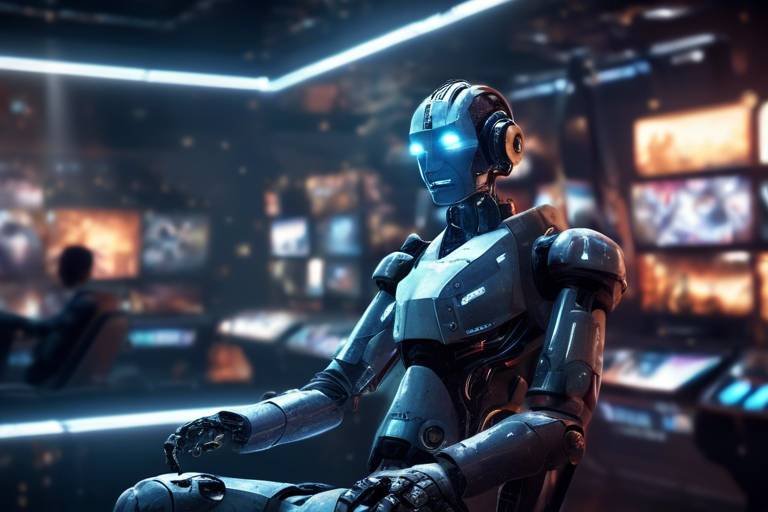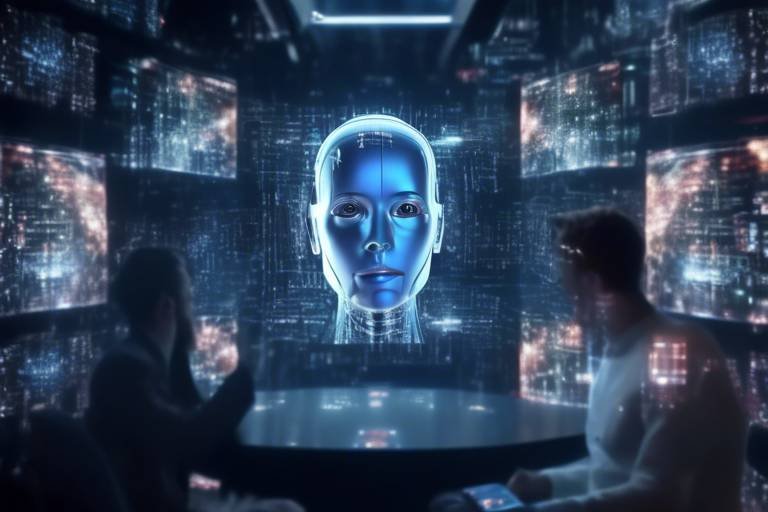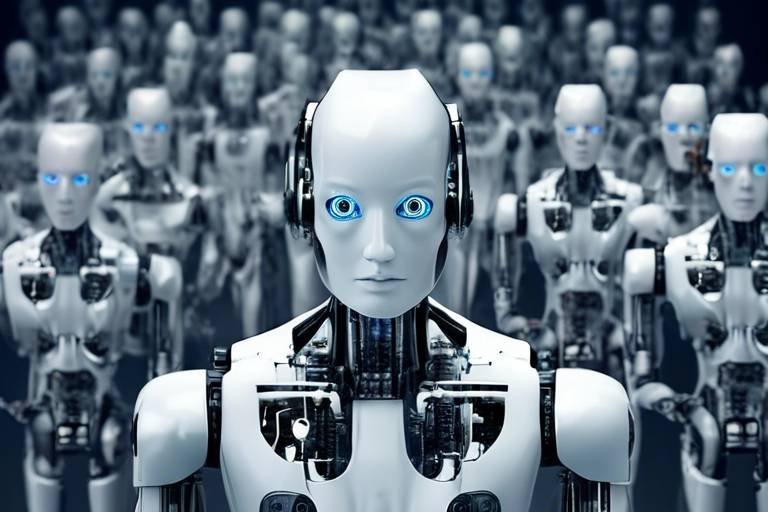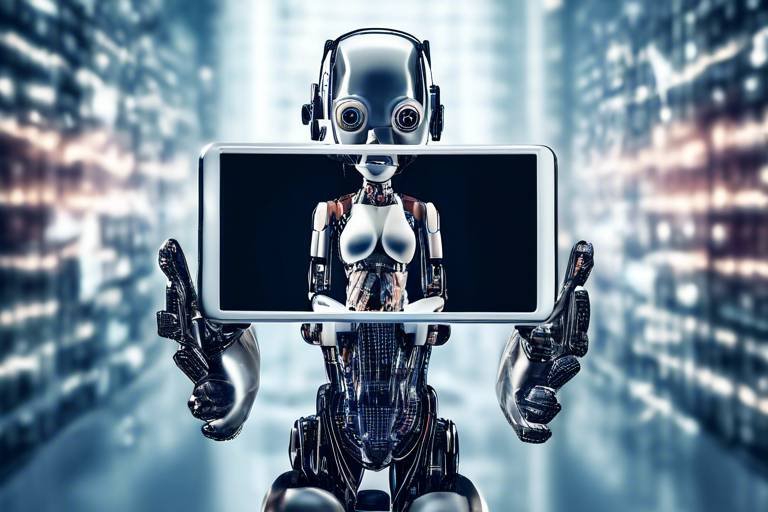The Role of AI in Gaming
Artificial Intelligence (AI) has become a game changer in the gaming industry, and it's not just a buzzword; it's a revolutionary force that is reshaping how we play. Imagine diving into a game where every character you encounter feels alive, where the environment adapts to your actions, and where the challenge evolves as you do. This is the new reality thanks to AI. It's like having a personal game designer who knows exactly what you want, pushing the boundaries of creativity and engagement. The integration of AI in gaming is enhancing player experiences, driving innovation in game design, and creating a whole new level of interactivity.
From the moment you start a game, AI is working behind the scenes to tailor your experience. It’s not just about flashy graphics or intricate storylines anymore; it's about creating an immersive world that responds to your choices and actions. This transformation is not only making games more enjoyable but also more accessible to a wider audience. As AI technology continues to evolve, the possibilities seem endless, leading us into an era where gaming can be as unique as each player.
In this article, we will delve into the various ways AI is transforming the gaming landscape. We’ll explore how AI-powered Non-Player Characters (NPCs) have become more lifelike, how procedural content generation is creating endless unique environments, and how adaptive difficulty adjustments keep the gameplay balanced for everyone. We won't stop there; we'll also look at how AI enhances player analytics, revolutionizes game testing, improves graphics and animations, and even introduces voice recognition for a more engaging experience. Lastly, we’ll gaze into the crystal ball and consider the future of AI in gaming. So, are you ready to level up your understanding of AI in the gaming world?
- How does AI improve NPC interactions?
AI allows NPCs to react and respond more like real humans, making interactions more engaging and believable.
- What is procedural content generation?
It’s a method where AI creates game content dynamically, ensuring that no two gaming experiences are the same.
- Can AI adjust the difficulty of a game?
Yes! AI can analyze how well a player is doing and modify the game's difficulty in real-time to keep the challenge just right.
- How does AI help in game testing?
AI automates the testing process, identifying bugs and issues more efficiently than human testers could.
- What is the future of AI in gaming?
The future holds even more sophisticated AI capabilities, leading to richer storytelling and more personalized game experiences.

AI-Powered NPCs
This article explores how artificial intelligence is transforming the gaming industry, enhancing player experiences, and driving innovation in game design and development.
Non-player characters (NPCs) have come a long way since the days of simple programmed responses and predictable paths. With the advent of artificial intelligence, NPCs are now capable of exhibiting a level of realism that was previously unimaginable. Imagine stepping into a game where the characters around you respond to your actions not just with pre-set dialogues, but with dynamic interactions that feel almost human. This transformation is not merely cosmetic; it fundamentally changes how players experience storytelling and immersion in games.
AI-powered NPCs utilize complex algorithms to analyze player behavior and adapt their actions accordingly. For instance, in a role-playing game, an NPC might initially greet you with suspicion, but as you complete quests and build rapport, their demeanor could shift to one of friendship and trust. This creates a layered narrative that makes players feel more invested in the game world. It's akin to watching a well-crafted movie where characters evolve based on their experiences—only in this case, you are the one shaping their journey.
Moreover, AI allows NPCs to exhibit a range of emotions and reactions, enhancing the overall narrative depth. They can express fear, joy, or anger based on the player's decisions, making each interaction feel unique. This emotional intelligence is crucial for creating a vibrant game world. For example, in a survival horror game, an NPC might panic and flee when they see a monster, while another might bravely attempt to fight back, depending on their personality traits programmed by the developers.
To illustrate the impact of AI on NPCs, consider the following table that compares traditional NPCs with AI-powered NPCs:
| Feature | Traditional NPCs | AI-Powered NPCs |
|---|---|---|
| Behavior | Pre-programmed responses | Dynamic and adaptive responses |
| Interaction | Limited dialogue options | Contextual and varied dialogue |
| Emotional Depth | Static emotions | Emotionally responsive |
| Player Influence | Fixed story paths | Branching narratives based on player choices |
It's not just about making NPCs smarter; it's about creating a more immersive experience for players. They become integral parts of the story, contributing to the game's emotional weight. This evolution in NPC design is a game-changer, offering players a sense of agency and connection that enhances their overall gaming experience.
As we look to the future, the potential for AI in NPC development is limitless. Imagine a world where every NPC is a unique character with their own backstory, motivations, and reactions to the player's actions. This level of detail could lead to games that feel less like a series of challenges and more like living, breathing worlds. With AI, the line between player and character blurs, creating an experience that is not only entertaining but also deeply personal.
- How do AI-powered NPCs enhance gameplay?
AI-powered NPCs create more realistic and immersive interactions, making players feel more connected to the game world. - What technologies are used in AI for NPCs?
Technologies like machine learning, natural language processing, and behavior trees are commonly used to develop intelligent NPCs. - Can NPCs learn from player behavior?
Yes, AI systems can analyze player actions and adapt NPC behavior accordingly, leading to unique gameplay experiences.

Procedural Content Generation
Imagine stepping into a game world that feels different every time you play. That’s the magic of Procedural Content Generation (PCG). With the help of advanced AI algorithms, developers can create vast, immersive environments that are not only unique but also tailored to each player's journey. Instead of manually crafting every single level or character, AI can generate content on-the-fly, providing players with fresh experiences that keep them coming back for more.
At its core, procedural content generation uses mathematical algorithms and rules to produce game elements dynamically. This means that every time you enter a game, you could be exploring a completely new landscape, encountering different quests, or even facing unique enemies. The beauty of PCG lies in its ability to create a sense of infinite possibility. Just like a painter uses different strokes and colors to create a masterpiece, game developers can use procedural techniques to craft entire worlds that feel alive and ever-changing.
One of the most notable examples of procedural content generation can be found in games like No Man's Sky, where entire planets are generated with diverse ecosystems, flora, and fauna. Players can explore these worlds, each with its own unique characteristics, providing a sense of adventure that is hard to replicate in traditionally designed games. The endless exploration and discovery keep players engaged, as they never quite know what they will find around the next corner.
Moreover, procedural generation isn't limited to just landscapes. It can also be applied to:
- Item Creation: Randomly generated loot can enhance replayability, as players hunt for that perfect weapon or armor piece.
- Quest Design: AI can create quests that adapt to player choices and actions, making each playthrough feel personalized.
- Character Features: Unique character traits and appearances can be generated, ensuring that no two players look alike.
This adaptability not only enriches the gameplay experience but also allows developers to save time and resources. Instead of laboring over every detail, they can focus on refining core game mechanics and storytelling. However, it’s important to note that while procedural generation offers incredible advantages, it also comes with its challenges. Ensuring that generated content is cohesive and meaningful can be tricky. Developers must strike a balance between randomness and design to prevent players from feeling lost in a sea of disjointed elements.
As we look to the future, the potential for procedural content generation is limitless. With advancements in AI and machine learning, we can expect even more sophisticated algorithms that create richer, more engaging worlds. Imagine a game that learns from your playing style and generates content that perfectly suits your preferences. This level of personalization could redefine how we interact with games, making them not just a pastime but a truly unique adventure tailored just for you.
Q: What is Procedural Content Generation?
A: Procedural Content Generation (PCG) is a method used in game development where algorithms create game content dynamically, allowing for unique experiences each time a player engages with the game.
Q: How does AI enhance PCG?
A: AI enhances PCG by using complex algorithms to generate diverse environments, quests, and items, leading to a more immersive and personalized gameplay experience.
Q: Can procedural generation create meaningful content?
A: Yes, while it can be challenging, developers can design algorithms that ensure generated content is cohesive and meaningful, enhancing player engagement.
Q: What are some examples of games that use PCG?
A: Games like No Man's Sky, Spelunky, and Rogue Legacy utilize procedural content generation to create unique worlds and experiences for players.

Adaptive Difficulty Adjustment
In the ever-evolving landscape of video games, one of the most exciting innovations is the concept of . Imagine diving into your favorite game, and instead of facing the same level of challenge throughout, the game subtly shifts its difficulty based on your performance. This dynamic approach ensures that players remain engaged, challenged, and most importantly, entertained. No one enjoys the frustration of hitting a wall in a game, nor do they want to breeze through it without any challenge. So how does this work?
At the heart of adaptive difficulty is artificial intelligence that continuously analyzes a player's actions in real-time. If you're breezing through levels like a pro, the AI might ramp up the difficulty by introducing tougher enemies or intricate puzzles. Conversely, if you're struggling, it can ease up, perhaps by providing more resources or adjusting enemy behavior to be less aggressive. This creates a personalized gaming experience tailored just for you, making each session feel unique.
The technology behind this is quite fascinating. Here’s a simplified breakdown of the process:
| Step | Description |
|---|---|
| 1 | Data Collection: The game collects data on player performance, such as accuracy, time taken to complete tasks, and frequency of failures. |
| 2 | Analysis: AI algorithms analyze the data to assess the player's skill level and engagement. |
| 3 | Adjustment: Based on the analysis, the game adjusts the difficulty level in real-time to match the player's capabilities. |
This intelligent adjustment not only enhances the player experience but also contributes to a deeper sense of immersion. Players feel as though the game is responding to them personally, which can lead to greater emotional investment in the gameplay. Imagine a game that feels like it knows you—your strengths, weaknesses, and even your play style. This level of personalization makes the gaming experience more rewarding and engaging.
Moreover, adaptive difficulty can help in reducing the dropout rate among players. Many players abandon games due to overwhelming challenges or lack of progression. By implementing an AI-driven adjustment mechanism, developers can ensure that players remain engaged without hitting frustrating roadblocks. This is particularly important in multiplayer games where maintaining a balanced experience for all players is crucial.
As we look to the future, the potential for adaptive difficulty adjustment is immense. With advancements in AI, we can expect even more sophisticated systems that not only adjust difficulty but also learn from players over time, creating a gaming experience that evolves just as much as we do. The days of static difficulty are fading, and in their place is a vibrant, responsive gaming world that adapts to our every move.
In conclusion, adaptive difficulty adjustment is not just a feature—it's a revolution in how we experience games. With AI at the helm, players can enjoy a tailored experience that keeps them on their toes, ensuring every gaming session is both challenging and enjoyable.
- What is adaptive difficulty adjustment?
Adaptive difficulty adjustment is a game design feature that alters the game's difficulty in real-time based on the player's performance.
- How does it enhance gameplay?
It keeps players engaged by providing a balanced challenge, preventing frustration and boredom.
- Is it used in all games?
No, not all games use adaptive difficulty, but its popularity is growing, especially in action and role-playing games.
- Can players turn it off?
Many games allow players to choose their preferred difficulty level, which can sometimes include turning off adaptive difficulty.

Enhanced Player Analytics
In the ever-evolving landscape of gaming, player analytics has become a cornerstone of game development. Imagine stepping into a virtual world where every move you make is carefully observed and analyzed—not in a creepy way, but in a way that enhances your overall experience. This is where artificial intelligence (AI) comes into play, transforming raw data into actionable insights that developers use to tailor games to player preferences. With AI-driven analytics, developers can delve deep into player behavior, uncovering patterns that were previously hidden beneath the surface.
One of the most exciting aspects of enhanced player analytics is the ability to track player engagement. By monitoring how long players spend in-game, which missions they favor, and even what items they purchase, developers can create a more personalized experience. For instance, if data shows that players are struggling with a particular level, developers can adjust the game mechanics or provide additional resources, ensuring that players remain challenged but not frustrated. It's like having a personal trainer for your gaming journey, guiding you through the tough spots while celebrating your victories.
Furthermore, AI can segment players into different categories based on their play styles. This segmentation allows developers to create targeted content that resonates with specific player groups. For example, casual gamers might appreciate simpler challenges and lighter storylines, while hardcore players may crave complex narratives and intricate puzzles. By understanding these differences, developers can enhance player satisfaction and retention rates. After all, nobody wants to feel like they're playing a game that doesn't cater to their style!
Another fascinating application of player analytics is in real-time feedback. Imagine playing a game where, instead of waiting for the next update, the developers can adjust the game mechanics on-the-fly based on your performance. AI systems can analyze your gameplay in real-time, identifying areas where you might be struggling and dynamically adjusting the difficulty. This not only keeps the game engaging but also ensures that players are always on the edge of their seats, eager to conquer the next challenge.
To give you a clearer picture, here's a simple table that illustrates how enhanced player analytics can impact game development:
| Analytics Focus | Impact on Game Development |
|---|---|
| Player Engagement | Adjust content based on playtime and activity |
| Play Style Segmentation | Create tailored experiences for different player types |
| Real-time Feedback | Dynamically adjust difficulty and game mechanics |
| Retention Rates | Improve player satisfaction and loyalty |
As we move forward, the role of AI in player analytics will only grow more significant. With advancements in machine learning and data processing, we can expect even more sophisticated insights that will help shape the future of gaming. Imagine a world where every game you play evolves based on your preferences, creating a unique experience that feels tailor-made just for you. That's the power of enhanced player analytics, and it's just the beginning of what AI can do in the gaming industry.
- What is player analytics? Player analytics refers to the process of collecting and analyzing data on player behavior to improve game design and player experience.
- How does AI enhance player analytics? AI enhances player analytics by processing large amounts of data quickly and providing actionable insights that can inform game development decisions.
- Can player analytics help with game balancing? Yes, player analytics can identify areas where players struggle, allowing developers to adjust game mechanics for better balance.
- Is player data used to personalize gaming experiences? Absolutely! Player data can be used to create tailored experiences that cater to individual preferences and play styles.

AI in Game Testing
Game testing has traditionally been a labor-intensive process, often requiring countless hours of manual playtesting to identify bugs and glitches. However, with the advent of artificial intelligence, this landscape is undergoing a monumental shift. AI tools are now stepping in to automate many of these repetitive tasks, making the testing process not only faster but also more efficient. Imagine having a virtual assistant that tirelessly plays through every nook and cranny of your game, catching bugs before they reach the players. Sounds like a dream, right? Well, that dream is becoming a reality!
One of the most significant advantages of using AI in game testing is its ability to perform automated regression testing. This means that once a bug is fixed, AI can quickly verify that the fix hasn’t caused any new issues elsewhere in the game. This is crucial in a world where games are constantly updated and patched. Without AI, developers might spend days manually checking for issues, but with AI, this can be done in a fraction of the time.
Furthermore, AI can simulate various player behaviors and scenarios, which helps in identifying potential gameplay issues that human testers might overlook. For instance, AI can execute thousands of different play styles and strategies, providing a comprehensive analysis of how the game performs under various conditions. This not only helps in fine-tuning the gameplay but also ensures that players have a seamless experience, free from frustrating bugs.
Let’s take a closer look at some of the key benefits of using AI in game testing:
- Speed: AI can test games much faster than human testers, allowing for quicker iterations and releases.
- Consistency: Unlike human testers who may have varying levels of attention and focus, AI provides consistent testing results every time.
- Comprehensive Coverage: AI can explore areas of the game that may not be frequently tested, ensuring that no stone is left unturned.
- Cost-Effective: By automating many testing processes, companies can save on labor costs and allocate resources more effectively.
Moreover, AI-driven analytics can offer valuable insights into player behavior during testing. By analyzing how testers interact with the game, developers can pinpoint areas that may need improvement. For example, if AI notices that players consistently struggle with a particular level or mechanic, it can flag this for further examination. This data-driven approach leads to more informed design decisions and ultimately results in a better product.
In conclusion, the integration of AI in game testing is not just a trend; it's a fundamental shift that is reshaping how games are developed and improved. As technology continues to advance, we can expect even more sophisticated AI tools that will further streamline the testing process and enhance the overall quality of video games. The future of game testing is here, and it's powered by AI!
- What is AI in game testing? AI in game testing refers to the use of artificial intelligence tools to automate the testing process, identify bugs, and ensure a smoother game launch.
- How does AI improve the efficiency of game testing? AI can perform tests much faster than humans, provide consistent results, and simulate various player behaviors, leading to quicker iterations and releases.
- Can AI completely replace human testers? While AI can automate many tasks, human testers bring unique insights and creativity that AI cannot replicate, making a combination of both the ideal approach.
- What are the future prospects of AI in game testing? As AI technology evolves, we can expect even more advanced tools that will enhance testing processes, improve game quality, and ultimately lead to better player experiences.

Realistic Graphics and Animation
In the world of gaming, realism has always been a crucial factor that enhances the player experience. With the advent of AI technologies, the bar has been raised significantly. Gone are the days of blocky characters and repetitive animations. Today, AI is transforming graphics and animations, making them more lifelike and immersive than ever before. Imagine stepping into a game where the characters move fluidly, their facial expressions change in real-time, and the environments react dynamically to your actions. This is not just a dream; it’s the reality that AI is helping to create.
One of the most exciting aspects of AI-driven graphics is its ability to analyze vast amounts of visual data. Through machine learning algorithms, AI can learn from real-world movements and apply this knowledge to create animations that mimic human behavior. For instance, when a character runs, AI can ensure that their limbs move in a way that feels natural, rather than robotic. This level of detail not only enhances the visual appeal but also deepens the emotional connection players feel with the game.
Furthermore, AI is revolutionizing the way developers create environments. Traditional game design often involved painstakingly crafting every detail of a scene, but AI can generate intricate landscapes and settings on the fly. By using procedural generation, AI can create unique terrains, weather patterns, and even ecosystems that react to player choices. This means no two playthroughs are ever the same, providing players with a fresh experience every time they log in.
Another fascinating development is the use of AI in texture generation. Textures are what give surfaces their unique characteristics, and AI can produce high-resolution textures that enhance realism without burdening system resources. This allows for more detailed environments and characters without compromising performance. Imagine walking through a forest in a game and seeing the bark on trees, the leaves rustling in the wind, and the sunlight filtering through branches—these elements come together to create a truly immersive experience.
Moreover, AI is also playing a significant role in lighting and shadow effects. Real-time lighting adjustments based on the game’s environment can drastically change the mood and atmosphere. AI can simulate how light interacts with different surfaces, creating shadows that move naturally as characters and objects shift. This not only adds depth to the visuals but also enhances gameplay by providing players with visual cues that can affect their strategies.
As we look towards the future, the potential for AI in graphics and animation is limitless. Developers are continually finding new ways to integrate AI into their workflows, leading to innovations that we can only begin to imagine. With each advancement, the line between reality and the virtual world blurs further, promising a gaming experience that is not just played but truly lived.
- How does AI improve graphics in games? AI enhances graphics by analyzing real-world data to create lifelike animations, generate detailed environments, and improve texture quality.
- What is procedural generation? Procedural generation is a method where algorithms create game content dynamically, resulting in unique terrains and settings for each player.
- Can AI create realistic character animations? Yes, AI can learn from human movements to produce animations that look natural and fluid, enhancing the overall gaming experience.

Voice Recognition and Interaction
In the ever-evolving landscape of gaming, voice recognition technology is taking player interaction to a whole new level. Imagine diving into a game where you can simply speak commands instead of navigating through endless menus. This isn't just a futuristic dream; it's a reality that many modern games are embracing. With the advent of AI-driven voice recognition, players can engage with their favorite titles in a more natural and immersive way. Whether you're commanding your character to perform a specific action or engaging in conversations with NPCs, the experience becomes more fluid and engaging.
One of the most exciting aspects of voice recognition in gaming is its ability to create a hands-free experience. Players can focus entirely on the action, allowing for a deeper immersion into the game world. This technology is particularly beneficial in multiplayer scenarios, where quick communication can mean the difference between victory and defeat. Imagine coordinating with your team in a fast-paced battle without having to fumble with a controller or keyboard. Instead, a simple voice command can relay strategies or call for assistance in seconds, enhancing team dynamics and overall gameplay.
Moreover, voice recognition isn't just about convenience; it's also about personalization. Many games are now integrating adaptive voice systems that learn from player interactions. This means the more you play, the better the system understands your preferences and speech patterns. For instance, if you often choose a particular character or strategy, the game can respond to your style, making interactions feel more tailored and unique. It's like having a personal gaming assistant that evolves with you!
However, the integration of voice recognition technology is not without its challenges. The technology must accurately understand a wide range of accents, dialects, and speech patterns to be truly effective. Developers are continuously working on improving the accuracy of these systems to ensure that players from all backgrounds can enjoy seamless interaction. Additionally, privacy concerns surrounding voice data collection are also at the forefront of discussions. Players need to feel secure that their voice data is handled responsibly and transparently.
As we look to the future, the potential for voice recognition in gaming is vast. We can expect to see even more innovative uses of this technology, from fully voice-activated game menus to dynamic storytelling where players' choices are reflected in real-time dialogue. The possibilities are endless, and as AI continues to improve, so too will our gaming experiences. So, next time you pick up a controller or headset, consider the incredible technology that allows you to speak your way through adventures, making gaming not just a hobby, but a truly interactive experience.
- What games currently use voice recognition technology?
Many popular titles, including Skyrim and Call of Duty, have integrated voice commands to enhance gameplay. - Is voice recognition available on all gaming platforms?
Most modern consoles and PCs support voice recognition, but the availability may vary by game. - How does voice recognition improve gaming?
It allows for hands-free interaction, enhances immersion, and enables personalized gaming experiences. - Are there any privacy concerns with voice recognition in gaming?
Yes, players should be aware of how their voice data is used and ensure they are comfortable with the privacy policies of the games they play.

AI in Multiplayer Games
In the vibrant world of multiplayer gaming, artificial intelligence (AI) is playing a crucial role in creating a balanced and engaging experience for players. Imagine diving into a game where every match feels fresh and unpredictable, yet fair—this is the magic that AI brings to the table. By analyzing player data and behaviors, AI systems can ensure that no one is left behind or overwhelmed, making the gaming experience enjoyable for everyone involved.
One of the most significant contributions of AI in multiplayer games is its ability to manage matchmaking. Gone are the days when players had to endure frustrating matches against opponents far beyond their skill level. AI algorithms can assess players' skills, preferences, and play styles, creating matches that are not only competitive but also fun. This intelligent matchmaking ensures that players are pitted against others who are at a similar skill level, which enhances the overall enjoyment of the game.
Furthermore, AI can help in maintaining game balance during multiplayer sessions. It monitors gameplay dynamics in real-time, adjusting variables like character abilities or item availability to ensure that one player doesn’t dominate the game. This level of adaptability keeps the gameplay exciting and prevents any single player or team from becoming too powerful, thus fostering a more competitive environment.
Another fascinating aspect of AI in multiplayer games is its ability to enhance social interactions. In many games, players communicate and collaborate with one another to achieve common goals. AI can analyze these interactions to suggest strategies or even help mediate conflicts, ensuring that players can focus on teamwork rather than getting bogged down in disputes. This creates a more enjoyable atmosphere where players can forge friendships and build communities.
Moreover, AI can introduce dynamic events within multiplayer environments. For instance, if a particular player is excelling, the AI might trigger a challenge or a new quest that requires teamwork to overcome. This not only keeps the game fresh but also encourages players to work together, enhancing the social fabric of the gaming community.
As we look to the future, the role of AI in multiplayer gaming is set to expand even further. With advancements in machine learning and data analytics, the potential for AI to create even more immersive and engaging multiplayer experiences is limitless. The games of tomorrow will likely feature AI that can predict player behavior, adapt to individual play styles, and even generate unique in-game events tailored to the preferences of the group.
In conclusion, AI is not just a tool but a game-changer in the realm of multiplayer gaming. It enhances matchmaking, balances gameplay, fosters social interactions, and introduces dynamic challenges that keep players engaged. As technology continues to evolve, we can expect AI to play an even more integral role in shaping the future of multiplayer gaming, ensuring that every player has a thrilling experience.
- How does AI improve matchmaking in multiplayer games?
AI analyzes player skills and preferences to create balanced matches, ensuring a fair and competitive environment. - Can AI help prevent cheating in multiplayer games?
Yes, AI can monitor gameplay for unusual patterns that may indicate cheating, helping to maintain a fair playing field. - Will AI take over the social aspects of multiplayer gaming?
While AI can enhance social interactions, it is designed to support, not replace, the human element of gaming. - How does AI create dynamic events in games?
AI can analyze player performance and interactions to trigger events that challenge players and promote teamwork.

The Future of AI in Gaming
This article explores how artificial intelligence is transforming the gaming industry, enhancing player experiences, and driving innovation in game design and development.
Non-player characters (NPCs) have evolved dramatically with AI, providing players with more realistic interactions and behaviors that enhance immersion and storytelling in games.
AI algorithms are now capable of generating vast amounts of content dynamically, allowing for unique game environments and experiences tailored to individual players.
AI systems can analyze player performance in real-time and adjust game difficulty, ensuring a balanced challenge that keeps players engaged without causing frustration.
Game developers utilize AI to gather and analyze player data, gaining insights into player behavior that inform design decisions and improve overall gameplay experiences.
AI tools are revolutionizing game testing processes by automating repetitive tasks, identifying bugs, and ensuring a smoother launch for new titles.
AI technologies are enhancing graphics and animations, allowing for more lifelike character movements and environments that create a more immersive gaming experience.
Voice recognition powered by AI is enabling players to interact with games in innovative ways, creating a more engaging and hands-free gaming experience.
In multiplayer environments, AI helps balance gameplay, manage matchmaking, and enhance the overall social experience, ensuring players have a fair and enjoyable time.
As we look towards the future, the role of AI in gaming is set to expand in ways we can only begin to imagine. With advancements in machine learning and neural networks, we can expect AI to create even more dynamic and responsive gaming experiences. Imagine a game where the world adapts not just to your choices, but to your emotions and playstyle. This level of personalization could lead to a gaming landscape where no two experiences are the same.
Moreover, AI is likely to enhance the storytelling aspect of games. By analyzing player decisions and interactions, AI could craft narratives that evolve in real-time, providing a uniquely tailored storyline that reacts to your every move. This could transform traditional linear narratives into complex, branching tales that feel alive, making players feel like they are not just part of the story, but the authors of it.
In terms of game development, AI tools will continue to streamline workflows, reducing the time and resources needed to create high-quality games. This could democratize game development, allowing indie developers to compete with larger studios by leveraging AI for everything from asset creation to testing.
Furthermore, the integration of AI into virtual reality (VR) and augmented reality (AR) could lead to unprecedented levels of immersion. Picture a VR game where NPCs not only react to your actions but also to your voice and facial expressions, making the experience feel incredibly real. This could blur the lines between the gaming world and reality, creating experiences that are not just played, but lived.
In summary, the future of AI in gaming is bright and full of potential. As technology continues to evolve, we can expect to see more innovative gameplay mechanics, richer storytelling, and immersive experiences that push the boundaries of what gaming can be.
- How will AI change the way games are developed?
AI will automate many aspects of game development, from asset creation to testing, allowing developers to focus more on creativity and storytelling. - Can AI improve player engagement?
Absolutely! AI can analyze player behavior and adapt the game experience to keep players engaged and challenged. - What role will AI play in multiplayer gaming?
AI will help to balance gameplay, manage matchmaking, and enhance the social experience, ensuring fair play for everyone. - Will AI make games more personalized?
Yes! Future AI advancements could lead to experiences tailored specifically to individual players' preferences and playstyles.
Frequently Asked Questions
-
How is AI transforming NPCs in games?
AI has revolutionized non-player characters (NPCs) by making their interactions more realistic and engaging. Instead of following predictable patterns, AI-powered NPCs can adapt their behaviors based on player actions, creating a more immersive storytelling experience. Imagine playing a game where the characters react to your decisions as if they were real people—this is the magic of AI!
-
What is procedural content generation and how does it work?
Procedural content generation uses AI algorithms to create game environments and assets dynamically. This means that instead of manually designing every level, developers can let AI generate unique landscapes, quests, and challenges tailored to each player. It’s like having an infinite playground, where every time you play, you discover something new!
-
Can AI adjust game difficulty based on my skill level?
Absolutely! AI systems can analyze your gameplay in real-time and adjust the difficulty to match your skill level. This ensures that you’re consistently challenged without feeling overwhelmed. It’s like having a personal coach that knows when to push you harder or when to ease up, making your gaming experience much more enjoyable.
-
How do game developers use player analytics?
Game developers harness AI to gather and analyze player data, which helps them understand player behavior and preferences. This insight allows them to tweak game mechanics, improve user interfaces, and create better overall experiences. Think of it as a feedback loop where players’ actions help shape the game itself!
-
What role does AI play in game testing?
AI is a game-changer in the testing phase of game development. It automates repetitive tasks, identifies bugs, and ensures that the game runs smoothly before launch. This means developers can focus on creativity and innovation, while AI takes care of the tedious parts. It’s like having a super-efficient assistant that never tires!
-
How is AI enhancing graphics and animations?
AI technologies are making graphics and animations more lifelike than ever. By using advanced algorithms, developers can create realistic character movements and stunning environments that draw players in. Imagine stepping into a game where everything looks and feels real—that’s the power of AI at work!
-
Can I interact with games using my voice?
Yes! AI-powered voice recognition allows players to interact with games in exciting new ways. Whether it’s giving commands to characters or navigating menus hands-free, voice interaction adds a whole new layer of engagement. It’s like having a conversation with your game!
-
What is AI's role in multiplayer gaming?
In multiplayer environments, AI helps manage gameplay balance and matchmaking, ensuring a fair and enjoyable experience for all players. It can analyze player skills and preferences to create balanced teams, making each match competitive and fun. Think of AI as the referee that keeps the game fair and exciting!
-
What does the future hold for AI in gaming?
The future of AI in gaming is incredibly bright! As technology continues to advance, we can expect even more innovative gameplay mechanics and storytelling possibilities. Imagine games that adapt to your emotions or create entirely new narratives based on your choices—this is just the beginning of what AI can achieve in the gaming world!



















